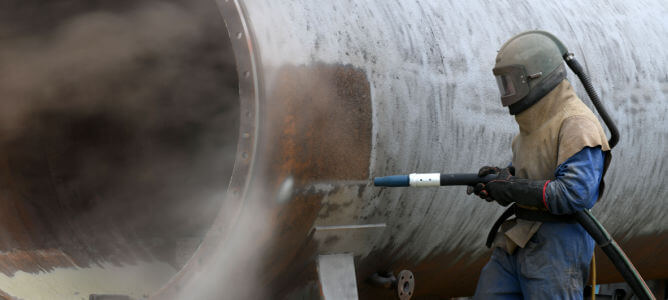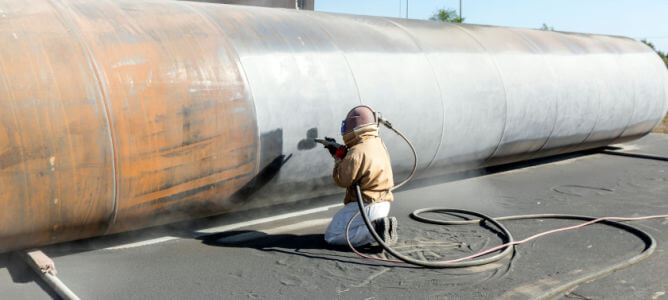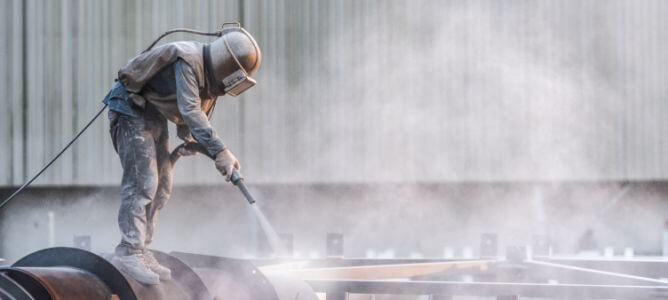
What Size Air Compressor Do I Need for Sandblasting?
Sandblasting is an effective way to remove rust, paint, and other coatings from a variety of surfaces. It is usually a time-consuming and messy process, but with the right equipment, it can also be incredibly smooth.
One of the most important pieces of equipment for sandblasting is the air compressor. Without it, the sandblaster won’t have enough power to remove the targeted coating effectively. Keep reading as we explain the factors that influence the size of the air compressor you need for sandblasting and help you choose the right one for your project.
What Are Air Compressors for Sandblasting?
Industrial air compressors are necessary for sandblasting because they provide the high-pressure air that propels the abrasive material onto the surface you intend to clean. However, not all air compressors are built for the job. When selecting an air compressor for sandblasting, you have to consider various factors, such as the pressure and volume of air it can deliver, as well as the horsepower rating.
Types of Sandblasters
There are three types of sandblasters, and they each differ in the way they introduce sand into the air.
Gravity-Fed Sandblasters
As the name suggests, a gravity-fed sandblaster relies on gravity to feed sand into the barrel of the gun from the top. This sandblaster has a hopper on top of the gun that holds your supply of sand as you work. When you pull the trigger, the sand is forced out of the barrel, and more sand from the hopper falls into the barrel to continue the process.
Pressure Blasters
A pressure blaster has a canister containing the sand, which is connected to a gun with a specialized hose. When you pull the trigger, the sand and air come out of the canister together. One of the major perks of using a pressure blaster is that it requires minimal maintenance.
Siphon Sandblaster
In a siphon sandblaster, the suction is going to be the main source of action. In this case, a gun is connected via two hoses to an air compressor and a sand reservoir. When compressed air flows through the first hose, it creates suction, which pulls the sand through and out of the barrel.

Choosing the Right Size Air Compressor for Sandblasting
So, what size air compressor do you need for sandblasting? The CFM and PSI are two of the most important factors to consider when selecting an air compressor for a sandblaster.
CFM
Sandblasting is a very demanding procedure. The higher the CFM (cubic feet per minute) rating of an air compressor, the better it is for sandblasting. CFM refers to the volume of air that the system can move in a minute.
For a powerful sandblasting experience, you need a compressor that can produce between 18 and 35 CFM. The industrial type of sandblasting is even more demanding and requires compressors with 50 to 100 CFM.
PSI
To run a sandblaster effectively, you need an air compressor with 90 to 100 PSI. PSI stands for pounds per square inch, and it refers to the pressure that the compressor system generates.
The air tank will drain while you’re sandblasting, and it is important to maintain a working PSI of around 50 to 90. If it drops below 50 PSI, the pressure won’t be sufficient to take material off, and you’ll have to wait for the compressor to catch up again.

Types of Air Compressors for Sandblasting
Sandblasting air compressors come in a variety of styles, and your options include:
1. Piston Air Compressor
Piston air compressors are the most popular and the least expensive. These compressors work by using one or more pistons that move up and down in a cylinder to compress air. When selecting a piston compressor, pay attention to the CFM volume at 100 PSI.
2. Single-Stage Air Compressor
A single piston compresses the air directly into the storage tank or through a delivery hose to the sandblaster or any other tool. When selecting a single-stage air compressor, aim to choose one that turns off at 150 PSI and on at 120 PSI so you don’t run low on blasting pressure.
3. Two-Stage Air Compressor
A two-stage air compressor is a type of piston air compressor that compresses air in two stages. After the first stage of compression, the compressed air is sent to a second cylinder for further compression. Two-stage air compressors are effective but expensive.
4. Rotary Screw Air Compressor
A rotary screw air compressor uses two rotating screws to compress air. Rotary screw air compressors produce more volume than piston-type compressors, but they are also more expensive.
5. Vertical Screw Air Compressor
A vertical screw air compressor is a type of rotary screw compressor that stands vertically. The motor and air tanks of these compressors are mounted on top of each other to maximize floor space. Vertical screw compressors are commonly used in industrial applications where space is limited.
Explore NiGen Air Compressors for Sandblasting Applications
If you want to get the best results from your sandblasting projects, you need a high-quality air compressor. At NiGen, we have a wide range of air compressors designed to deliver the power and performance needed for industrial sandblasting.
Contact us to learn more about our products and find the perfect air compressor for your needs.
